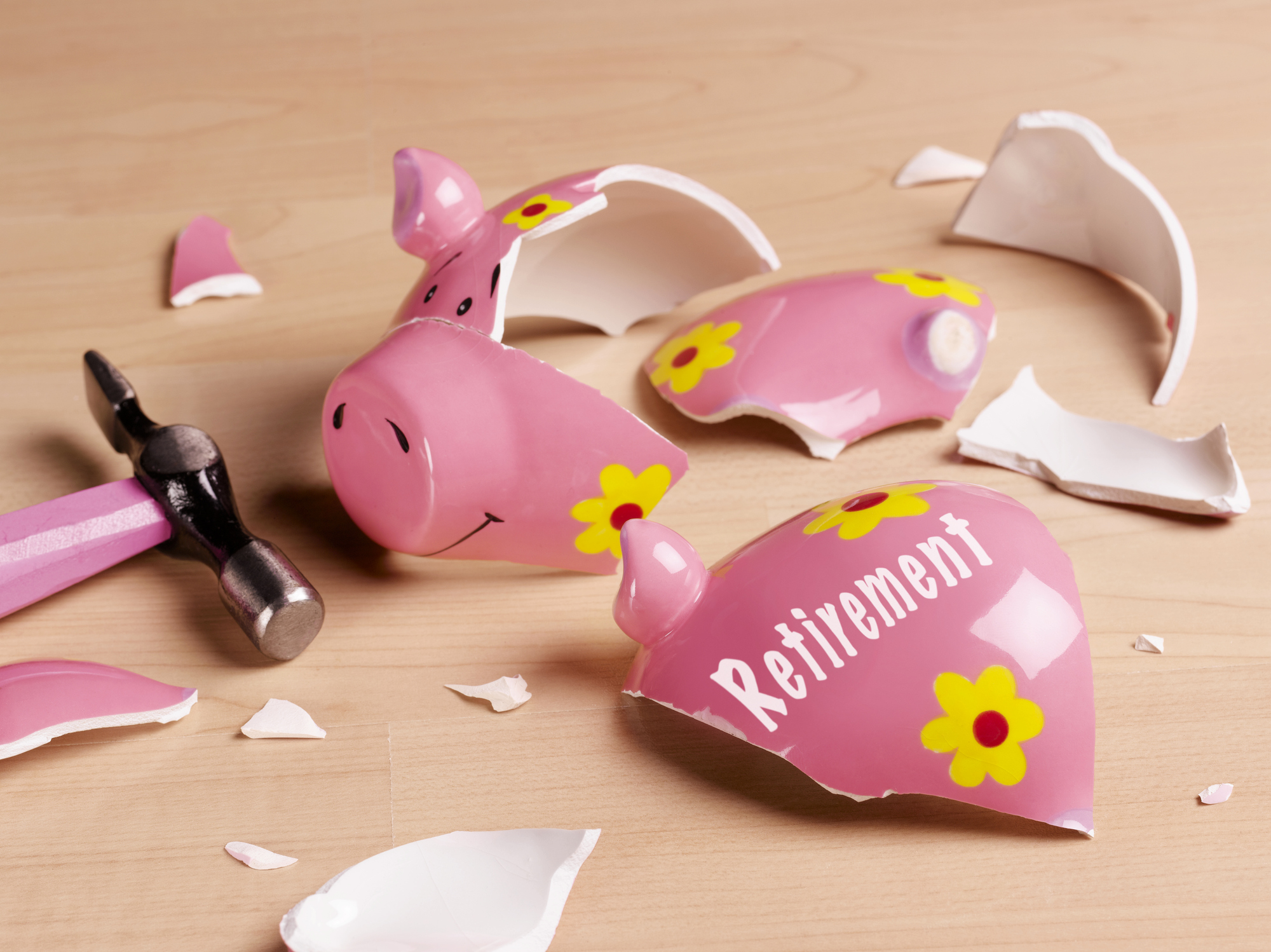What pension providers don't tell you about your retirement money
Check the small print from your pension provider or risk losing thousands.


The money pages of the weekend papers are often pretty miserable. But one piece in the Financial Times particularly stands out.
Claer Barrett told us about Martin, a 59-year-old forced into early retirement after developing a disability. He checked up on the value of his pension in June 2021 and found it was worth £200,000. He checked again in October 2023 and that number was £134,000. A third was gone.
What on earth, you might ask, went wrong?
MoneyWeek
Subscribe to MoneyWeek today and get your first six magazine issues absolutely FREE

Sign up to Money Morning
Don't miss the latest investment and personal finances news, market analysis, plus money-saving tips with our free twice-daily newsletter
Don't miss the latest investment and personal finances news, market analysis, plus money-saving tips with our free twice-daily newsletter
The answer, says Barrett, is “lifestyling”, a system used by pension-fund managers to cut the risk in portfolios as their beneficiaries age. When you are young, your manager invests your money in equities – after all, if things go wrong, you have plenty of time to make the money back, and history shows very few ten-year periods and even fewer 20-year periods in which equity investors don’t come out ahead. However, as you head towards retirement age, your risk of losing money in the equity market rises – there are plenty of five-year periods in which equity investors do not come out ahead. With that in mind, your provider moves your money into something safer as you age. That is, bonds.
I have a small pension, from a past employment, with Aviva, which, ten years before my retirement date, “aims to avoid large falls in the value of your pension by having a greater amount of money in less risky assets such as government and corporate bonds”. By the time you hit retirement, the odds are your fund will be entirely invested in various bond funds – as it looks like mine will be. This sounds good – and for years worked pretty well.
But as Martin found out, it doesn’t always work. Far from it. When interest rates rise, the capital value of bonds falls (to create a higher yield).
In the UK the bank rate has gone from nearly nothing to 5.25% over a matter of just two years. And here we are. Bond prices have nosedived. Last year some bond funds saw losses of 30% (just as bond prices rise when interest rates fall, they fall as interest rates rise). Martin was being lifestyled into a bond fund that fell 50% as rates rose.
So much for avoiding large falls in the value of your pension pot.
Pension pot mistakes to avoid
1. You cannot and should not place blind trust in your pension provider
In the main, they do an adequate job, albeit at slightly too high a cost but when it comes to lifestyling, they have failed significantly. That the bond market was in a bubble – that rates could really go no lower and may well go rather higher – should have been no surprise at all. This was well flagged across the markets and in the press (MoneyWeek warned on it several times).
In sticking with lifestyling even as an obvious bond bubble built, the managers made portfolios more rather than less risky. That’s really not OK.
2. Inertia
Most of us end up in a default fund of some kind, structured based on the expectation that we will buy an annuity with our lifestyle pot when we retire.
The existence of one default encourages inertia: we mostly don’t buy annuities any more (we keep our pot and enter drawdown), but without being forced into choices we can easily just accept bad options (as I may have). The pension managers should perhaps encourage us to think a little more. That said, more of us should take the time to read the small print.
Aviva is careful to let its clients know the risks:
- They move your money automatically on set dates, “so your money may not be moved at the time that gives the best return on your investment”.
- They’ll be moving the money into lower-return assets over time, so “there is a greater possibility that the investment funds we move your money into may not cover your charges”.
- And “there’s no guarantee that any of these strategies will prove beneficial to your pension pot”.
How to safeguard your pension?
Having read that small print, what should you do?
One answer is nothing. You might think the worst is over for the bond market. Inflation has been coming down (perhaps it was “transitory” after all) and that suggests that interest rates will, too – and that bond prices will be at least more stable.
But that inflation will fall back to 2% and stay there is very far from a given. Rising geopolitical conflict, and in particular the supply-chain disruption resulting from conflict in the Red Sea, could easily bring us another nasty bout of inflation – in our new world it is hard to be clear that the equity-bond shift will once again be consistently low-risk.
You might also ask yourself why, if you are not buying an annuity, you want to de-risk in the first place. You want your pension fund to provide you with an income for life. That means you need to hang on to significant equity exposure indefinitely (the dividends available on UK equities being, as one independent financial adviser puts it, “nature’s annuity”).
Once you have retired you should also question the wisdom of holding bond funds at all rather than just a couple of individual gilts. Hold these to redemption and you will definitely get your money back. You don’t have that reassurance with a corporate bond and you don’t have it with a bond fund, either.
As an aside, remember that if you are creating an income outside a self-invested personal pension (SIPP), capital gains on a bond fund will be subject to capital gains tax, whereas those on an individual gilt will not be.
Next steps
Step one, then, is to check on your pension – and how it is invested. Not all providers’ websites are good for this. You might need to telephone to ask what you have and what the other options are. You might be able to shift to a fund with less embedded risk for now and then find a way to de-risk your own portfolio (with gilts, for example) later.
Finally, if you are particularly lazy and simply want to avoid being lifestyled into bonds in the shorter term, you can go on to your provider’s website and change your retirement age. The later you make it, the longer until the automatic lifestyling kicks in. That might give you a bit more time to consider matters.
This article was first published in MoneyWeek's magazine. Enjoy exclusive early access to news, opinion and analysis from our team of financial experts with a MoneyWeek subscription.
Get the latest financial news, insights and expert analysis from our award-winning MoneyWeek team, to help you understand what really matters when it comes to your finances.
Merryn Somerset Webb started her career in Tokyo at public broadcaster NHK before becoming a Japanese equity broker at what was then Warburgs. She went on to work at SBC and UBS without moving from her desk in Kamiyacho (it was the age of mergers).
After five years in Japan she returned to work in the UK at Paribas. This soon became BNP Paribas. Again, no desk move was required. On leaving the City, Merryn helped The Week magazine with its City pages before becoming the launch editor of MoneyWeek in 2000 and taking on columns first in the Sunday Times and then in 2009 in the Financial Times
Twenty years on, MoneyWeek is the best-selling financial magazine in the UK. Merryn was its Editor in Chief until 2022. She is now a senior columnist at Bloomberg and host of the Merryn Talks Money podcast - but still writes for Moneyweek monthly.
Merryn is also is a non executive director of two investment trusts – BlackRock Throgmorton, and the Murray Income Investment Trust.
-
 Nationwide: House price growth slows but market remained resilient despite Budget worries
Nationwide: House price growth slows but market remained resilient despite Budget worriesThe average price of a house in the UK was £272,998 in November, as annual house price growth slowed to just 1.8%, Nationwide said.
-
 ChatGPT turns three: what’s next for the ‘AI era’?
ChatGPT turns three: what’s next for the ‘AI era’?Three years after its launch kickstarted the age of AI, ChatGPT and its maker OpenAI are driving the stock market. But concerns are growing over whether OpenAI will be able to turn its AI dominance into profit.
-
 Big Short investor Michael Burry closes hedge fund Scion Capital
Big Short investor Michael Burry closes hedge fund Scion CapitalProfile Michael Burry rightly bet against the US mortgage market before the 2008 crisis. Now he is worried about the AI boom
-
 The global defence boom has moved beyond Europe – here’s how to profit
The global defence boom has moved beyond Europe – here’s how to profitOpinion Tom Bailey, head of research for the Future of Defence Indo-Pac ex-China UCITS ETF, picks three defence stocks where he'd put his money
-
 Why the Waspi women are wrong
Why the Waspi women are wrongOpinion Compensation for the Waspi women would mean using an unaffordable sledgehammer to crack a nut, says David Prosser
-
 Profit from a return to the office with Workspace
Profit from a return to the office with WorkspaceWorkspace is an unloved play on the real estate investment trust sector as demand for flexible office space rises
-
 New frontiers: the future of cybersecurity and how to invest
New frontiers: the future of cybersecurity and how to investMatthew Partridge reviews the key trends in the cybersecurity sector and how to profit
-
 An “existential crisis” for investment trusts? We’ve heard it all before in the 70s
An “existential crisis” for investment trusts? We’ve heard it all before in the 70sOpinion Those fearing for the future of investment trusts should remember what happened 50 years ago, says Max King
-
 8 of the best properties for sale with wildlife ponds
8 of the best properties for sale with wildlife pondsThe best properties for sale with wildlife ponds – from a 16th-century house in the Ashdown Forest, to a property on Pembrokeshire’s Preseli Hills
-
 Why a copper crunch is looming
Why a copper crunch is loomingMiners are not investing in new copper supply despite rising demand from electrification of the economy, says Cris Sholto Heaton
